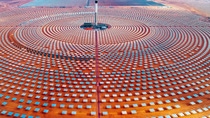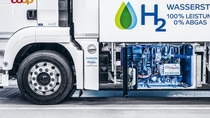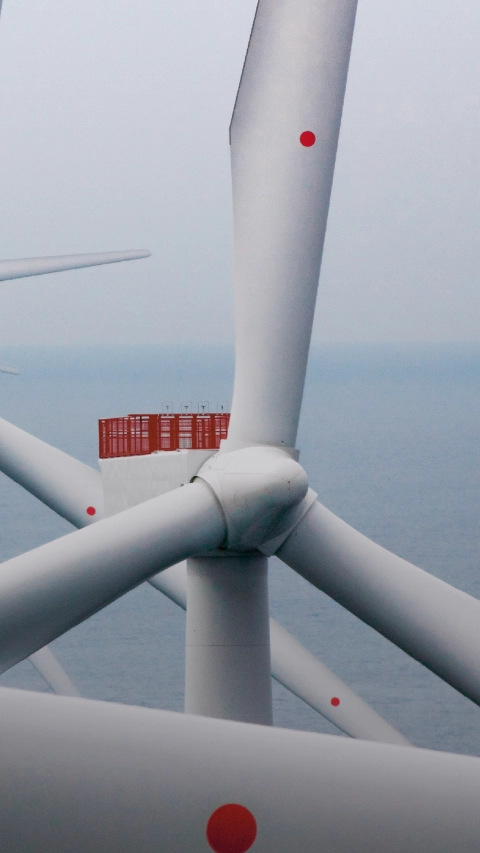Magazine
Energizing the world
We are facing a twofold energy challenge: meeting growing demand while also lowering emissions. This decade will be decisive for the transition from fossil fuels to renewables.

Rows of mountain peaks, covered in snow for 150 days of the year – an idyllic winter picture-postcard scene in Zhangjiakou. Some competitions of the 2022 Winter Olympics are due to take place in this city of millions in China’s Hebei Province. The aim is to offer more than just sporting superlatives: Beijing is promising “climate-friendly winter games.” A strategy for the next 30 years, developed by Zhangjiakou with organizations including the International Renewable Energy Agency (IRENA), is to show the city the way to switch to renewables. Its mountainous, water-rich region offers excellent geological conditions for pumped-storage power plants and an estimated 30 gigawatts of solar power and 40 gigawatts of wind energy, according to the strategy.
Zhangjiakou is intended to set an example for other cities in the country, as China looks for a sustainable way to manage rapid urbanization in the coming decades. Zhangjiakou became China’s first National Renewable Energy Demonstration Zone in 2015, and forms part of the energy revolution that was enshrined in 2016 in the 13th five-year plan for the development of the Chinese economy. “The goal is to develop a clean, low-carbon, safe and efficient energy system by 2050,” says Wang Zhongying, deputy director-general of the China National Renewable Energy Centre and a co-author of the strategy paper.

From fossil fuels to renewables, energy systems are being transformed not only in China, but all over the world. Increasing the use of renewable energies such as solar and wind power is one of the central elements in achieving the Paris climate goals. This is because fossil fuels, such as oil, natural gas, and coal, are the biggest source of greenhouse gases resulting from human activities and lead to global warming. To limit global warming to less than 2 degrees Celsius, countries in the European Union are seeking to reduce their net carbon dioxide (CO2) emissions to zero by 2050. Cities and regions all over the world are hurrying ahead with even more ambitious targets. Den Haag is planning to become climate-neutral by 2030, Reykjavik by 2040. Copenhagen has set the goal of becoming the world’s first CO2-neutral capital by 2025. It already has wind turbines supplying a large proportion of its energy.
The Danish capital is one of the C40 cities – a network of 97 major cities, from Addis Ababa to San Francisco to Karachi, that have come together to implement the Paris Agreement goals at local level. For example, since buildings are responsible for about half of all emissions in cities, it is planned that all newbuilds in New York and other C40 member cities should be able to operate on a climate-neutral basis from 2030. Since 2019, it has also been a requirement in New York legislation that all new buildings should be fitted with solar cells or have roofs covered with grass or other vegetation. The mayors of 35 cities, including Birmingham, Oslo and Tokyo, have committed themselves to order only emission-free buses from 2025.

Trend toward electrification
The share of electricity in overall energy demand will continue to rise significantly in the future, especially for the major energy guzzlers: mobility, heating, refrigeration. This presents the world with a dual challenge: people need more and more electricity as the hunger for energy grows at the same pace, while greenhouse gas emissions need to fall in parallel. The change that has happened in 2020 may be only short-term.
“The coronavirus crisis did initially lead to a fall in CO2 emissions on a scale we have not seen since the Second World War,” says Professor Manfred Fischedick, Scientific Managing Director of the Wuppertal Institute for Climate, Environment and Energy, Germany. However, he adds, economic recovery and catch-up effects mean that prepandemic emissions levels will probably be reached again within just two years. The scientist demands a “consistent change of course toward clean energy systems,” so that CO2 emissions can fall on a sustained basis and effective measures to limit climate change can be implemented as quickly as possible.

“The measures that are taken in this decade will be decisive in determining whether climate protection succeeds or fails,” warns Lord Adair Turner, Chairman of the Energy Transitions Commission (ETC), a global association of prominent figures from business, finance and society. The aim is both to reduce emissions quickly in order to limit the increase in CO2 in the atmosphere and to achieve net zero emissions in the energy and industry sectors by mid-century. “To achieve this, energy efficiency must be improved and the use of carbon based energy sources in electricity generation must be reduced. In addition, as much of the economy as possible must be electrified with electricity from renewable sources,” explains Turner.

More renewable energy for the chemicals industry
This goal has been on BASF’s agenda for a long time. In its carbon management research and development program, the company is researching fundamentally new production technologies to enable energy-intensive industrial processes to be switched to a renewable energy supply. For instance, an interdisciplinary research team is working on projects that include the development of an electric-powered steam cracker. Naphtha is split into olefins and aromatics – important building blocks for all chemical products – at temperatures of 850 degrees Celsius in petrochemical facilities. “If we succeed in converting the cracker from natural gas to renewable electricity, we could save up to 90 percent of the resulting CO2,” says Dr. Andreas Bode, manager of the carbon management research and development program at BASF in Ludwigshafen, Germany. The challenge is that an electrically-heated steam cracker has to have a reliable supply of very large amounts of electricity, and at competitive prices. “For the steam cracker alone, we would need the electricity from more than a hundred large wind turbines,” Bode says. “This also requires policymakers to make the big decisions to ensure that this works.”
Energy storage: new ideas for more flexibility
Differences in the electricity mix
In 2018, renewables accounted for 32 percent of the electricity mix in the European Union, 26 percent in China, 19 percent in India, and about 17 percent in the USA, Russia and Japan. Despite all the green rays of hope, global energy-related CO2 emissions continue to rise. China demonstrates the dilemma: although the country invests the most in renewable energies of any country in the world, the energy hunger of this huge nation also makes China the global leader in coal consumption. Head of State Xi Jinping wants to change this in the long term and announced that his country will be climate-neutral by 2060. In the foreseeable future, however, China will continue to rely on electricity from coal. The situation is similar in the USA, Japan and India, which rank second to fourth in the list of the world’s biggest coal consumers. In 60 countries worldwide, including Bangladesh, Vietnam and Indonesia, coal-fired power stations with a capacity of around 580 gigawatts were at the construction or planning stage in 2019, according to recent calculations by 30 environmental and climate protection organizations for the Global Coal Exit List project. This is equivalent to an increase in installed capacity of about 30 percent of the amount of electricity presently available from coal.
Hydrogen produced with no CO2 emissions is one source of hope in the energy transition. Hydrogen is not merely a substance to power the future of the transportation transition. It also supplies energy in industry and is used in substantial quantities as a reaction partner in the chemical industry. The production of hydrogen currently releases large amounts of CO2. “There is great potential for reducing CO2 emissions in hydrogen production,” Bode says. The subjects of BASF’s research here include new, emission-free processes for producing hydrogen.

Increasing importance of long-term storage
Hydrogen is not only usable in industry or transportation, but can also be stored long-term in large quantities. In the future, this could be a solution to one pressing question relating to renewables: How can the surplus energy created on sunny and windy days be stored and then made available flexibly for those times when conditions are cloudy and windless? As well as hydrogen, stationary batteries are also suitable for the long-term storage of energy from renewable sources. The two technologies have different areas of application. Whereas hydrogen is suitable as an energy source for a period of several months, batteries are used as a long-term storage facility for energy for up to 12 hours. One tried-and-tested technology here comes in the form of NAS® batteries (sodium-sulfur batteries with high energy content). These are particularly suitable for the integration of renewable energies into power grids and can also support a constant supply of power in locally demarcated power networks known as island grids. BASF New Business is cooperating globally in their distribution and in the development of a new generation of NAS batteries with NGK Insulators Ltd., a leading Japanese company.
Producing emission-free energy and having it constantly available in the necessary volume is one side of the coin. The other is energy consumption.

A lot of energy is needed – not just for digitalization, but also to make rooms livable. This makes energy efficiency all the more important. The global hunger for energy will grow by 25 percent by 2040. Source: International Energy Agency 2018, scenario taking account of existing and planned laws.
How can we use less energy for the same or even bigger tasks? “The smart way,” says Jatin Nathwani, Professor of Sustainable Energy Policy at the Canadian University of Waterloo: “Advances in information and communication technologies are making it possible to build a networked world with a much smaller ecological footprint than today.” One practical example of the digitalization of the energy transition is the smart grid, which has been trialed since 2012 in the desert nation of Qatar. It is composed of networked computers that communicate with each other, managing electricity demand and automatically drawing on energy storage facilities. Small-scale digitalization could also help with the United Nations goal of finally including the 10 percent of people worldwide who are still living without electricity. “Digital technologies like mini-grids will bring electricity to rural, poorer communities without the need to invest in a huge centralized grid,” says Nathwani.
There are two sides to digitalization
We cannot win the fight against global warming without digital solutions. But at the same time, digital technologies have an immense hunger for energy. Intelligent networks, cloud applications in business, and the streaming of movies and music - all mean that the daily volume of data handled is growing inexorably. According to a study commissioned by the U.S. International Data Corporation (IDC), every person with internet access in the Europe, Middle East and Africa economic area will by 2025 be using digital data in some form about 5,000 times a day, or once every 18 seconds – and every click consumes electricity. This means efficiency will become ever more important. According to Koomey’s law, the energy efficiency of computers has doubled every 2.7 years since 2000. A similar trend is being observed in data transmission networks.
The problem here is that, in the past, the growth in use was greater than the gain in efficiency. Although processors are indeed yielding better and better performance with lower consumption, more and more people are simultaneously using more and more energy-intensive services. “To prevent this rebound effect, we have to raise the question of what is the correct amount – meaning, sufficiency,” Fischedick says. In relation to digital technology, this means counteracting overconsumption – not constantly buying the latest smartphone, occasionally clearing your device’s memory, and not letting your usage get out of hand.
Which items use and produce how much power
To make units of measurement easier to understand, we have combined them with consumption values* – but these depend on many factors and vary by model and manufacturer. The averages and approximate values are therefore intended only as a rough guide.
* One watt-hour (Wh) is the amount of energy used by one watt of electric power over a period of one hour.
The obstacle to energy saving
The economical and sensible use of energy accordingly places a responsibility on the consumer. In theory, energy saving can be as simple as taking a shower instead of a bath, cycling or using a carpool instead of driving on your own, and buying an efficient refrigerator but not continuing to use the old one in the cellar. Although people know all this, they find it hard to change their behavior, says Fischedick. Hardly anybody will give up cherished habits, convenience or time savings just for the sake of cutting back on energy. “Present-day societies actually change only once the pressure is already very great – when there is, in effect, hardly any alternative course of action left. However, in the light of the coronavirus crisis, climate protection may at last become a higher priority,” hopes the Managing Director of the Wuppertal Institute.
The team of the international consortium Affordable Energy for Humanity Global Change Initiative around co-founder Professor Nathwani focuses on participation for behavioral change: “Technological solutions for a sustainable energy supply are not enough; they must work in the respective cultural context.” This means: take your time, listen to local people, and work together to find possible solutions.












